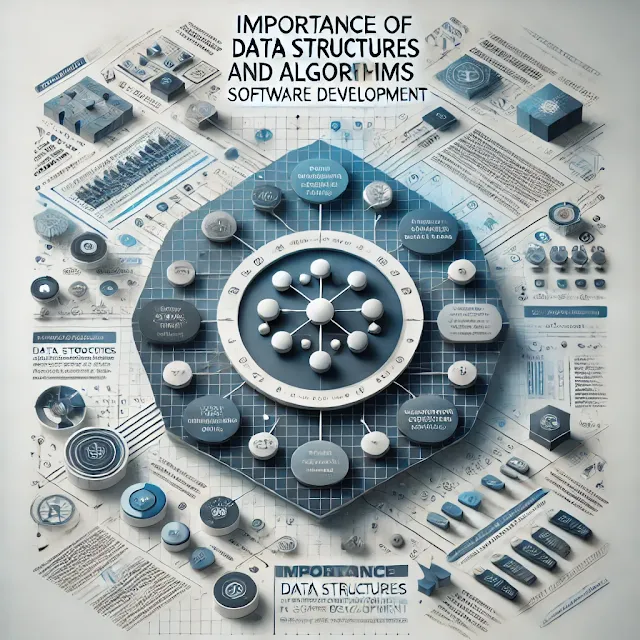Have you ever wondered what separates great software developers from the rest? While creativity and communication are key, a deep understanding of data structures and algorithms (DSA) often defines success in the tech world. DSA isn’t just about solving coding puzzles; it’s the foundation of efficient, scalable, and impactful software.
Whether you’re a recent graduate, an entry-level programmer, or just starting your coding journey, mastering DSA can set you apart, open doors to exciting opportunities, and help you thrive in your career.
Why Data Structures and Algorithms Matter
When I began my coding journey, DSA seemed intimidating. But as I progressed, I realized that it’s more than just theoretical knowledge. It’s the key to solving complex problems efficiently and building software that can handle real-world challenges.
Here’s why DSA is critical for every programmer:
1. Efficient Problem-Solving
Imagine you’re tasked with finding the shortest route between two cities on a map. Without the right tools, this could take forever. Enter DSA! Concepts like graph algorithms and shortest-path methods provide structured ways to tackle such problems efficiently.
By learning DSA, you’ll develop a problem-solving mindset. You’ll learn to break down challenges, analyze requirements, and implement solutions that work under varying conditions.
2. Optimizing Performance
Have you ever encountered a program that runs painfully slow? Performance optimization is where DSA truly shines. Algorithms like sorting, searching, and hashing help speed up execution time.
Here’s an example:
Searching for a name in an unsorted list of 1,000 entries could take up to 1,000 steps. But using a binary search algorithm on a sorted list reduces this to just 10 steps.
DSA isn’t just about speed—it also ensures optimal memory usage. Understanding structures like arrays, linked lists, and hash tables lets you store and access data efficiently without wasting resources.
3. Career Advancement
Want to land a job at top tech companies like Google, Microsoft, or Amazon? Their hiring process revolves around DSA. Coding interviews often include challenges like implementing sorting algorithms or solving problems using divide-and-conquer strategies.
When I prepared for interviews, I spent hours practising questions on arrays, recursion, and graph traversal. This not only improved my technical skills but also boosted my confidence. If you aim for career growth, DSA is your ticket to the next level.
4. Data Presentation
Structured data is easy to manage, analyze, and interpret. DSA gives you the tools to organize data effectively, making it accessible and meaningful.
Consider trees and graphs:
- Trees, like binary search trees, make it easy to retrieve sorted data.
- Graphs help model real-world networks, from social connections to traffic systems.
By mastering these structures, you’ll be able to design software that’s intuitive and functional.
5. Scalability
As software grows, so do the challenges it faces. Scalability ensures that a system can handle increasing users, data, or traffic without breaking down. DSA provides the building blocks for creating scalable systems.
Take a look at web applications that serve millions of users. Behind the scenes, they use optimized algorithms to manage data and handle requests efficiently.
Key Examples of Data Structures and Algorithms
Let’s dive into a few core examples to understand DSA better:
Sorting Algorithms
Sorting is a common task, from organizing names in alphabetical order to arranging numbers in ascending order.
- QuickSort: A divide-and-conquer algorithm that splits a list into smaller parts and sorts them independently.
- MergeSort: Another divide-and-conquer approach, ideal for large datasets.
When I implemented QuickSort for the first time, I was amazed at how splitting and conquering simplified a seemingly complex task.
Divide and Conquer
This category of algorithms breaks problems into smaller subproblems, solves them, and combines the results.
- Binary Search: Great for finding elements in sorted data.
- Dynamic Programming: A method to solve problems by reusing solutions to overlapping subproblems.
Arrays
One of the simplest yet most powerful data structures, arrays store elements in adjacent memory locations.
They are perfect for scenarios where data needs to be accessed quickly, such as in-game development or real-time systems.
Working with arrays taught me how simplicity can be powerful. They’re versatile, easy to understand, and serve as the foundation for more complex structures.
How to Build Your DSA Skills
Mastering DSA takes time, but it’s worth every second. Here’s how you can get started:
1. Start with Basics
Focus on understanding simple structures like arrays, stacks, and queues. Gradually move on to trees, graphs, and dynamic programming.
2. Practice Regularly
Platforms like LeetCode, HackerRank, and Codeforces offer a variety of challenges to test your skills.
3. Apply to Projects
Integrate DSA concepts into your personal or academic projects. For instance, use sorting algorithms to manage data in an e-commerce application.
Conclusion
Data structures and algorithms are the backbone of software development. They make your programs faster, smarter, and more efficient. As a programmer, mastering DSA will not only boost your problem-solving skills but also open doors to endless career opportunities.
If you haven’t started yet, don’t worry—it’s never too late. Dive into the basics, stay consistent, and remember: “Every expert was once a beginner.”
